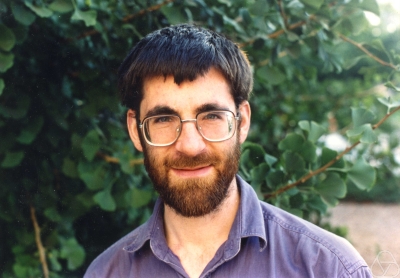- Richard Borcherds
Infobox_Scientist
name = Richard Borcherds

caption =
birth_date = birth date and age|1959|11|29
birth_place =Cape Town ,South Africa
residence =UK , U.S.
nationality = English
death_date =
death_place =
field =Mathematician
erdos_number = 2
work_institution =University of California, Berkeley ,University of Cambridge
alma_mater =University of Cambridge
doctoral_advisor =John Horton Conway
doctoral_students =Daniel Allcock ,Alexander Barnard ,Tathagata Basak ,Scott Carnahan , Oliver King,Peter Niemann ,Sankaran Viswanath
known_for = Lattices,number theory ,group theory
societies = Fellow,Royal Society
prizes =Fields Medal (1998)
spouse =
children =
religion =
handedness =
website =
footnotes =Richard Ewen Borcherds (born
November 29 ,1959 ) is a Britishmathematician specializing in lattices,number theory ,group theory , and infinite-dimensional algebras. He was awarded theFields Medal in 1998.Personal life
He was born in
Cape Town and educated atKing Edward's School, Birmingham and Cambridge University, where he studied underJohn Horton Conway . After receiving his doctorate he has held various alternating positions at Cambridge and theUniversity of California, Berkeley . He is currently Professor of mathematics at Berkeley, having previously held a Royal Society Research Professorship in Cambridge.In his teens Borcherds was ranked as one of the most promising chess players in the UK.Fact|date=November 2007 An interview with
Simon Singh forthe Guardian , in which Borcherds suggested he might have some symptoms ofAsperger's syndrome , [ [http://www.simonsingh.com/Fields_Medallist.html Guardian interview with Borcherds following award of Fields medal] ] subsequently led to a chapter in a bookbySimon Baron-Cohen . [citation|first=Simon|last=Baron-Cohen|authorlink=Simon Baron-Cohen|title=The Essential Difference: Male and Female Brains and the Truth about Autism|publisher= Basic Books|year=2004|id=ISBN 046500556X. Chapter 11, "A Professor of Mathematics" (see external links) records conversations with Richard Borcherds and his family.] [ [http://www.guardian.co.uk/Archive/Article/0,4273,4103969,00.html High flying obsessives] , The Guardian, December 2000]Work
Borcherds is best known for his work connecting the theory of
finite group s with other areas in mathematics. In particular he invented the notion ofvertex algebra s, whichIgor Frenkel ,James Lepowsky andArne Meurman used to construct an infinite-dimensional graded algebra acted on by themonster group . Borcherds then used this, and methods fromstring theory , to prove theConway-Norton conjecture , relating the monster to the coefficients of the q-expansion of thej invariant . The result was not only a great increase in understanding of themonster group , a very large finite simple group whose structure was previously not well understood, but tied the monster to various aspects of mathematics and mathematical physics. (Seemonstrous moonshine .) In recent years, Borcherds has been attempting to construct quantum field theory in a mathematically rigorous manner.Awards
In 1992 he was one of the first recipients of the EMS prizes awarded at the first
European Congress of Mathematics inParis . In 1998 at the 23rdInternational Congress of Mathematicians inBerlin , Germany he received theFields Medal together withMaxim Kontsevich ,William Timothy Gowers andCurtis T. McMullen . The award cited him "for his contributions to algebra, the theory of automorphic forms, and mathematical physics, including the introduction of vertex algebras and Borcherds' Lie algebras, the proof of the Conway-Norton moonshine conjecture and the discovery of a new class of automorphic infinite products."References
ources
* Conway and Sloane, "Sphere Packings, Lattices, and Groups", Third Edition, Springer, 1998 ISBN 0-387-98585-9.
* Frenkel, Lepowsky and Meurman, "Vertex Operator Algebras and the Monster", Academic Press, 1988 ISBN 0-12-267065-5.
* Kac, Victor, "Vertex Algebras for Beginners", Second Edition, AMS 1997 ISBN 0-8218-0643-2.External links
* [http://www.ams.org/notices/199810/comm-fields.pdf "Borcherds, Gowers, Kontsevich, and McMullen Receive Fields Medals"] , "Notices of the American Mathematical Society", Volume 45, Number 10 (November 1998).
* James Lepowsky, [http://www.ams.org/notices/199901/fields.pdf "The Work of Richard Borcherds"] , "Notices of the American Mathematical Society", Volume 46, Number 1 (January 1999).
* Richard Borcherds, [http://www.ams.org/notices/200209/what-is.pdf "What is ... The Monster?"] , "Notices of the American Mathematical Society", Volume 49, Number 9 (October 2002).
* Simon Singh, [http://www.simonsingh.com/Fields_Medallist.html "Interview with Richard Borcherds"] , "The Guardian" (28 August 1998).
* [http://math.berkeley.edu/~reb Richard Borcherds' web site] (has links to some relatively informal lecture notes describing his work)
* [http://news.bbc.co.uk/1/hi/education/153535.stm BBC News (1998): British academics win top maths awards]
* [http://leitl.org/docs/a-professor-of-mathematics.pdf A Professor of Mathematics]Persondata
NAME= Borcherds, Richard
ALTERNATIVE NAMES=
SHORT DESCRIPTION=Mathematician
DATE OF BIRTH=November 29 ,1959
PLACE OF BIRTH=Cape Town ,South Africa
DATE OF DEATH=
PLACE OF DEATH=
Wikimedia Foundation. 2010.
